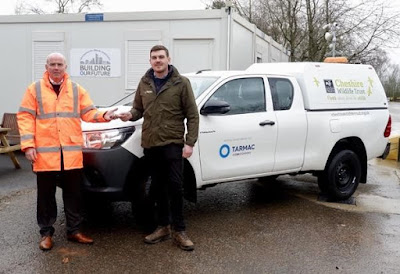Visitors continue to come to Cleaver Heath in all weathers. Many come regularly to exercise their dogs and others stumble across it while exploring the rural delights of west Wirral. All enjoy the stunning views which vary according to the weather, light conditions and tides in the Dee Estuary. The sunset photo here is just as it came out of my camera – no funny business, I swear.
The fine new interpretation board, whose installation I highlighted in the Autumn Newsletter, has been joined by strategically placed arrowed way markers.
As you can see, the noticeboard has now been baptised with snow as well as rain.
Reassuringly, the newly stoned path has stood up very well to rain/sleet/snow and heavy usage. This was another key part of the Tesco Bags of Help scheme (more later).
Fewer visitors are finding it necessary to deviate from the main path. The close-up photo of the heather covered in snow was taken from the official path now signed through the north-east section of the heather panel. Likewise, the sunset view photo was taken from the path without resort to trampling across the heather.
Nevertheless, we do have to venture off-piste when carrying out our main conservation work.
This year, I have to confess to disturbing a Woodcock on 3 occasions this winter. Two were down in the lower heathland panel - labelled B in the habitat/working area map shown below. These lovely winter visitors resemble a snipe in general shape and come from Eastern Europe. They lie low during daylight and feed after dusk. The third occasion on which I disturbed one was when collecting piles of dog waste in the woodland edge of area G. It shot out on its typical 20° flight path, weaving between the trees until it got to Oldfield Road where it swerved sharply and shot up the road. You can easily see that this fine photo is not one of mine, as usually featured in these newsletters, but is a professional one from the Wildlife Trust’s stock (c. Mark Hamblin/2020VISION).
On the topic of dog waste, the presence on the main noticeboard of a sign about keeping dogs on a lead has been very helpful, but there are still regular users failing to pick up. In an 8-day period last week I collected an unbelievable 34 piles. I have put up a temporary notice drawing dog owners’ attention to the nearness of a regularly emptied litter bin just outside the new northern entrance. My volunteers deserve to have clear paths and verges from which to work and the heather deserves a quiet life on unenriched soil.
Winter work parties have gone well this year. I like to think that the systematic cutting and stump treatment really is having an effect. In years gone, by it took us until the end of the cutting season to complete our work. This season we had completed it before Christmas. The regrowth was much reduced. This was a direct benefit of the Trust’s Natural Futures programme which paid for herbicide training and the purchase of related equipment. As a result, we have been able to make use of volunteer effort on more varied tasks! People who want to get a better idea of what work is done where may find the following map helpful.

The main manual work removing birch, bramble, bracken and European gorse is in the heathland panels labelled A and B. In these areas saplings are pulled (sometimes with the ‘Tree Poppers’) or cut and painted with glyphosate. The ‘scrub’ areas such as D and F are coppiced selectively i.e. we cut the older/taller birch and gorse. The aim is to hinder the natural succession which would take place in this small heathland area while keeping good low-level shelter for wildlife. The nest boxes in the woodland areas C, I and G have now been given a final clear-out ready for spring. We hope to get help again this year with removing the bracken litter from area E (listed as ‘Restoration?’. This has been sprayed twice and raked twice. It would be a shame if we don’t manage to keep on top of it. Natural England has been very keen that we try to extend the heathland areas. We know from the soil sampling that this is feasible - in principle.

Finally, I should offer a big thank you to Tesco for their ‘Bags of Help’ scheme and to all of you Tesco shoppers who put their blue tokens in the correct box. The Trust’s Living Landscape Officer Kevin Feeney, in particular, put a lot of effort into leading multiple bids to the Bags of Help Scheme for several Trust reserves and then leading the installation.
Notice the attention to detail here – not just one spirit level but two. Community Conservation Coordinator Fiona Megarrell (on the right here) will be back later in February to welcome some staff from Tesco to check out the reserve and perhaps also help with some suitable practical work.
Alan Irving
Volunteer Reserve Warden for CWT
Cleaver Heath
February 2019
















